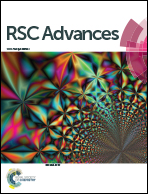Insight into the electronic and thermodynamic properties of NbSi2 from first-principles calculations†
Abstract
The electronic and thermodynamic properties of NbSi2 with four structures (C40, C11b, C54 and C49) were studied in terms of first-principle calculations. The band structure and density of states of four NbSi2 are calculated. Those disilicides show electronic properties because the band gap between the conduction band and the valence band is near the Fermi level. Their metallic character is mainly due to the strong metallic interaction between the Nb-4d state and Si-3p state. The formed Si–Si covalent bond is mainly concentrated in the valence band. The valence electron configuration of Nb–Si and Si–Si bonds is also explored. Besides, we study the thermodynamic properties of NbSi2 as a function of temperature. The results indicate that the C54 structure has the best thermal stability in the obtained phases. In particular, the Debye temperature and heat capacity of the C54 structure are 547.8 K and 142.7 J mol−1 K−1, respectively. The calculated phonon DOS provides the explanation that the nature of the thermodynamic properties is mainly derived from the vibration of Si atoms.



 Please wait while we load your content...
Please wait while we load your content...